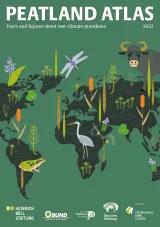

Peatlands cover about 24 million hectares in Southeast Asia, about 40 percent of the world’s tropical peatlands. The largest area of peatlands is in Indonesia, with about 20 million hectares, followed by Malaysia, with 2.6 million hectares. Most have developed on lowland floodplains in areas of high rainfall. Peat accumulates mainly in swamp forests, forming deposits up to 20 metres thick. It forms much faster than in temperate regions because of the year-round growing conditions, but it can also degrade much more quickly when drained or cleared.
The region’s peatlands are of global importance for biodiversity conservation. The peat swamp forests are highly diverse, with more than 1,000 species of higher plants recorded, including 45 that are unique to this habitat. Some sites have more than 250 tree species. The fauna is also very diverse, with 123 mammal species, 268 different birds, 75 reptiles, and 219 fish species recorded. About 45 percent of the mammals and 33 percent of the bird species are on the International Union for Conservation of Nature’s Red List of Threatened Species. The peatlands also provide habitat for many rare and endangered fish species, with more than 30 new species described in recent years, many of which are restricted to single sites.
In addition, the peatlands in Southeast Asia provide a range of ecosystem services, including water and food supply, flood control and carbon storage. They store an estimated 68.5 billion tonnes of carbon, making them one of the largest terrestrial carbon stores. And they are also an important source of timber and of many non-timber forest products like fish, rattan, honey and latex. Peatland ecosystems provide significant benefits to Indigenous peoples and local communities who live in and around them.
During the past 30 years, the region’s peatlands have been degrading very rapidly. In Sumatra, Kalimantan and Peninsular Malaysia (which account for almost two-thirds of the region’s peatlands), the area of peatland covered by swamp forests fell from 76 percent in 1990 to just 29 percent in 2015. A mere 6 percent is classified as pristine. Drainage of peatlands in Southeast Asia is responsible for 15 percent of the global CO₂ emissions from land use, land use change and forestry. Fires in degraded peatlands in the region are estimated to additionally emit a similar amount on average and significantly more CO₂ in drought years, making drained peatlands one of the largest sources of greenhouse gas emission in the region and globally. The protection and restoration of peatlands has therefore become an important component of national strategies for climate mitigation, as well as for biodiversity conservation and efforts to combat land degradation. The main causes of degradation have been the large-scale development of palm oil and forest plantations, combined with logging, drainage and fires.
Peatland degradation and fires have had massive social, environmental and economic impacts. The approximately 6 million hectares of peatlands that have burned in the last 25 years (particularly during El Nino-related droughts) have produced massive clouds of smoke, or haze, affecting more than 50 million people. The 2015 haze caused an estimated 100,000 premature deaths in the region, and economic losses of between 16 and 28 billion US dollars in Indonesia alone.
The Association of Southeast Asian Nations (ASEAN) adopted their Peatland Management Strategy for the years 2006 to 2020. This has been extended to 2030. It provides a broad framework for the long-term protection and sustainable use of peatlands and for the development of national action plans and landscape management plans.
Indonesia, with the region’s largest area of both peatlands and peat fires, has undertaken major reforms. It has halted the conversion of peatlands for agriculture and plantations, and adopted a wide range of new regulations and policies. It has pioneered an approach to manage the hydrology of peatlands. All peatlands in the country must be mapped and divided into conservation and utilisation zones based on their hydrology, peat depth and importance for conservation.
More than 50 percent of the peatlands in the country have been zoned for conservation, although only 15.6 percent of these peatlands are in formally protected areas. Groundwater management structures have been installed and improved on nearly 4 million hectares. As a result, peatland fires have significantly declined, degradation and subsidence of production areas have decreased and good progress has been made with restoration.

